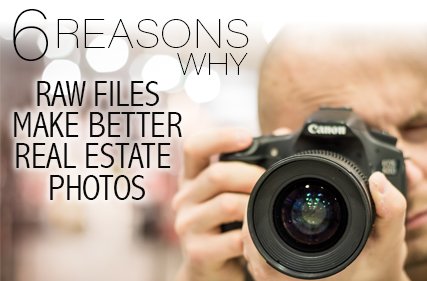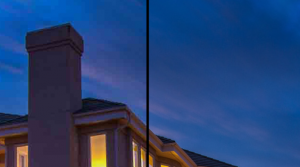 Okay…you’re probably asking yourself “what the heck is a RAW photo”? And, no…shooting in RAW doesn’t mean leaving your clothes in the car when you take the pics. RAW is a file format to which many cameras give you the option of saving. You may have even seen it in one of the menus on your camera and just skipped past it and stuck with the camera’s default of the JPG file format. Even though converting RAW files to JPG (i.e., something that can be viewed on a website) adds a step that you didn’t have to do before (or maybe even a few steps…), the advantages are many. Here’s my list of 6 Reasons Why RAW Photos Make Better Real Estate Photos:
Okay…you’re probably asking yourself “what the heck is a RAW photo”? And, no…shooting in RAW doesn’t mean leaving your clothes in the car when you take the pics. RAW is a file format to which many cameras give you the option of saving. You may have even seen it in one of the menus on your camera and just skipped past it and stuck with the camera’s default of the JPG file format. Even though converting RAW files to JPG (i.e., something that can be viewed on a website) adds a step that you didn’t have to do before (or maybe even a few steps…), the advantages are many. Here’s my list of 6 Reasons Why RAW Photos Make Better Real Estate Photos:
-
RAW Files Contain More Data.
Without getting into too much technical detail, RAW files are capable of displaying considerably more colors than, for example, JPG files. JPG’s are 8-bit, meaning that they can store 256 shades of red, green and blue…which results in a total combination of 16 million different colors. Doesn’t sound too bad, right? Maybe. However, a 12-bit RAW file can store 4,096 shades of each color for a total of 68 billion (with a “b”) combinations of colors. Some camera manufacturers even support 14-bit RAW files, which results in over 4 trillion (with a “tr”) color combinations. JPG files discard a whole lot of color data compared to RAW files.
-
All That Data Means More Flexibility Later.
So what difference does all that data make? It gives you a whole lot of options after the fact for making your photos look better. The RAW file stores 100% of all the light data that the sensor collects (that’s why it’s called a “lossless” file format). When you open that file in software that is capable of reading all that data (Adobe Lightroom, Photoshop etc) it gives you significantly ability to adjust than if you are working with a JPG file. What does that mean for Real Estate photos? Say you exposed a shot so that the window isn’t totally blown out (overexposed). That brown couch may end up looking pretty much black. If you have all that extra data, you can boost the darker colors to bring back that missing detail from underexposed sections of your photo.
-
RAW Photos Have Greater Dynamic Range.
I could probably teach an entire class on the limitations of dynamic range on modern digital cameras. Come to think of it, I actually do teach that class. At the risk of oversimplifying things, digital cameras are not capable of reproducing the dynamic range (the difference between the brightest and darkest parts of a scene) that we are able to see with the human eye. Real Estate Photography is one of the most challenging forms of photography from a dynamic range perspective because we are always taking photos of dark insides of homes with super bright windows. There’s some tricks to overcoming that, (take my class to learn a few!), but shooting in RAW format will give you a wider dynamic range right out of the camera than if you’re shooting in JPG format.
-
Fixing Mistakes After The Shoot.
Obviously it is best to get everything done exactly right at the time you take the photo. But if you’re anything like me…you can make mistakes. That can be especially true when taking photos inside a home. Have you ever taken a picture and when you look at it back at the office it has a ghastly greenish tinge to it? Guess what? The homeowners were using fluorescent bulbs in their lights in that room and your camera didn’t pick up on it. Your White Balance is all messed up and that room now looks like it is filled with noxious gasses. The RAW file format stores ALL the data from the camera, including the white balance the camera used to take the picture. You can actually change the white balance of a RAW file with the click of a mouse after the fact to overcome issues such as this.
-
RAW Files Have No Compression.

Compressed (left) vs. Uncompressed (right). Take note of the sky. I mentioned this earlier when I talked about RAW being a lossless file format, but it’s worthy of its own point. JPG files are a “lossy” format, and RAW files are a “lossless” format. What does that really mean, though? Sure, JPG’s discard information…but who cares, right? I bet every one of you has seen a highly “lossy” photo but didn’t realize it. JPGs discard information via image compression. The JPG compressor basically looks at all the pixels in an image and how different they all are. If there’s two (or more) pixels next to each other that are similar in color, it will make them the same color and discard the real color info. Have you seen a photo that looks all ‘blocky’? That’s nasty image compression at work. Take a look at the image to the right and see the difference between a compressed (on the left) and clean image.
-
It Will Make You A Better Photographer.
I know, I know…you’re a Real Estate Agent, not a photographer. But if you take your own photos instead of hiring a professional, you will do your clients a service to improve your photography skills. Listings with professional looking photos get more traffic than ones with lousy (or no) photos. No question, it will take you a few more minutes to process a RAW file versus a JPG, but once you get a grasp of how to do that in a program such as Adobe Lightroom you will start to shoot your photos in a different way. You’ll start to look at things from the perspective of reducing the amount of post-processing that will be necessary, or realize that there’s ways to fix things after the fact. Your clients will thank you.
As Real Estate Agents, time is absolutely at a premium. We all have different skill sets…and some agents just don’t want to deal with photos. That’s fine. Pay somebody else to do it and you will be happy with the results (I hope!!). But if you take your own photos but want to improve, look at shooting in RAW. Just don’t shoot in the raw.
Leave a Reply
You must be logged in to post a comment.